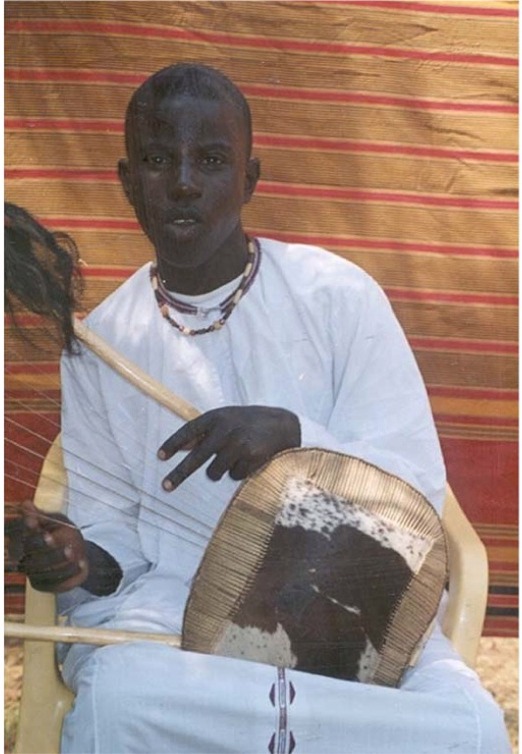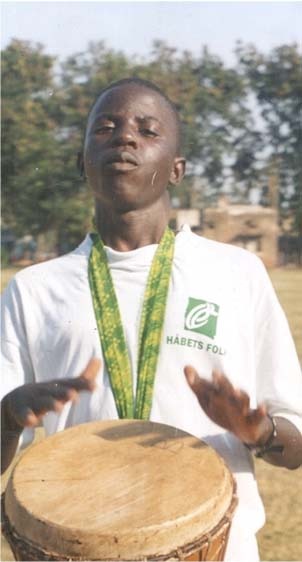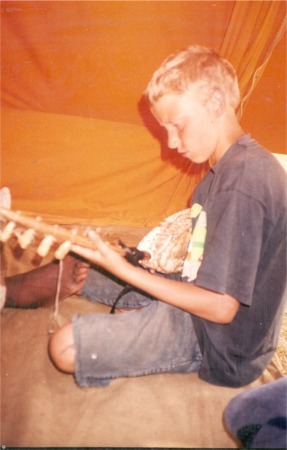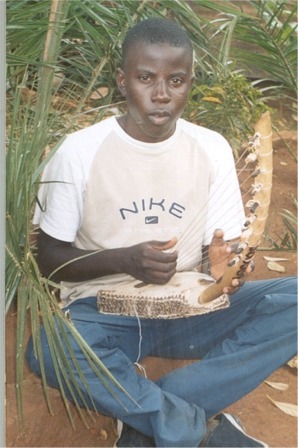|
|
|
| Meet Sebunjo Joel, the folk musician from uganda | |
|
|
 |
|
send me a message now |
 |
|
Born on 20th August 1984,in kampala-Uganda,sebunjo joel is in the 140th lineage of the mamba generation,has studied and perfomed Ganda music since the age of six.He comes from the Buganda kingdom whose history dates back as far as
the 17th century. Til to date it is one of the strongest kingdoms in the
Greatlakes region. Sebunjo hails from the madfish clan which is the largest
since time
immemorial.Sebunjo is a dynamic endongo(8 stringed ganda lyre) and endere(4 hole bamboo ganda flute) player.He also plays the 12 slab Amadinda (similar to the balofon though it ha no gourds)which he learned first with his grandfather and other master gandas of Buganda.Though born in the contemporary era,he inherits an acient art form whose foundation was laid by the Ganda ancetors.Sebunjo went into apprentinceship under legendary Ganda royal court musicians Dr.Albert sempeke,Ludoviko serwanga,Busulwa Katambula,Kayizzi Arthur,Balikowa centurio to mention but a few.He has perfomed with Akadinda K'Africa cultural troupe,Nkwanzi performers,Trio Africa,Abarere foundation,Endongo ethnic quartet and currently he is part of the dynamic peace african youth ensemble.Sebunjo has appeared at the FDF Julsoe- sletten 2001, Uganda national secondary schools festival,Makerere university cultural music gala as well as the MAPA Festival-Uganda.Sebunjo is well acqainted with avariety of Ganda art forms but in addition to them he has gone along to exploit the music of other ugandan cultures.He is proud to have friends and mentors all over the world that have assisted him in his endavours."You know the road to sucess as a musician is not that friendly,it has got hills and valleys hence one needs support and guidance to reach his destination.I therefore thank Rev.Evatt Mugarura of the Balm in Gilead-USA,Mr.Dantes Kashangirwe-National secretary Boys Brigade of Uganda,Matthew Smith and Gareth Harrison-Boys Brigade UK,Martin Vanderspek-Spektours Canada,Makerere college school Arts society,Albert Bisaso-Abarere Foundation and all those who love Folk music long live!"Below sebunjo takes us through the various aspects of the lore and Uganda as anation at large.
The Republic of Uganda is an independent nation in central Africa (East Africa), bordered on the east by Kenya, on the south by Tanzania and Rwanda, on the west by Zaire, and on the north by Sudan. The country has many lakes and swamps, among them Lake Victoria and Lake Kioga, both of which flow into the Nile river. Other lakes include Lake Edward and Lake Albert. Although most of Uganda is flat, there are volcanic mountains, including the Ruwenzori, which straddle Uganda's border with Zaire. as well as Mount Elgon near the border with Kenya. Southwestern Uganda is also mountainous. The rest of the country is made up of grassy woodlands and, in the northeast, semi-desert. A large variety of wildlife can be found throughout Uganda. Two of the country's many sanctuaries for wild animals are Kabalega National Park in the northwest and Lake Mburo National Park in the south.
There are four ethnic groups thriving in Uganda: Bantu "Bushmen" (the most numerous), Nilotic "Negroes", Nilo-Hamitic "Hamites" and Sudanic "Cushites". The contrasts between the various peoples of Uganda reflect the multiplicity of its culture, traditions, and lifestyles. Uganda has been created by the union of many people, ancient people with their own traditional lands, their own customs and a way of life inherited from their ancestors. This has made it acquire a cultural diversity especially in Music and Dance.
- The Bushmen are small people, short and light skinned. These form the original population of the mountainous areas and forests. Their natural surrounding gave them a rich variation in small percussion instruments, wooden horns and other small portable instruments and with simple dances. The musical point of view of the Bushmen had a significant influence on the general population of Uganda.
- The Negroes were tall, strong and dark skinned people who lived on the plains of river banks. These people knew a much wider and more developed set of instruments which included; different kinds of drums, all kinds of string instruments, flutes, other wind instruments and thumb pianos. The development of their complex society went hand in hand with the cultural development. According to the Negroes, music was played for the kings, chiefs, other dignitaries, cultural ceremonies and meetings or festivities.
- The Hamites were tall, athletic and light skinned people. They originally came from the northern areas of Africa trekking with gigantic herds of cattle. Their sets of instruments was limited and these included; flutes, small horns and small portable string instruments. Their music influence spread easily due to their trekking which brought them in contact with many different cultures. This created several instruments in Uganda that are said to have come from the Arab world.
Ugandas people can be classified into several broad linguistic groups: the bantu-speaking majority, who live in the central, southern and western parts of the country; and non-bantu speakings who live in the eastern, northern and northwestern part of the country (who maybe we can split in sub-groups similar the nilotic and central-sudanic people). The first category includes the large and historically highly centralized kingdom of Buganda, the smaller western Uganda kingdoms of the Bunyoro, Nkore and Toro and the Busoga states to the centraleast of Uganda. The peoples in the second category include the Iteso, Langi, Acholi, Alur, Karamojong, Jie, Madi, and Lugbara in the north and a number of other smaller societies in the eastern part of the country.
-The music of Uganda people is generally rhythmic and the complexity of these rhythms differ due to the difference between the 4 major ethnic groups. The variation in instrumentation also leads back to those mentioned differences. Some music has very simple instruments while the other type of music is played for dances and also in ensembles. The African music is pentatonic but sometimes hexatonic in scale to some tribes. Most of the Ugandan vocal music is usually accompanied by traditional instruments. The literaturely embedded in the vocal music is purposely meant to transform the social communities i.e. structural adjustment.
The Baganda make up the largest ethnic group in Uganda,(The name Uganda, the Swahili term for Buganda)Buganda is located in central Uganda and it is a region of the Baganda tribe.
A long time ago, it seems that many Bantu societies were organised along matrilineal lines, and were governed by women; a whole heap of oral legends testifies to this, and female founding ancestors - where they exist in tradition - are as venerated and respected as their male counterparts.
Song and Dances of Bantu Women.
The music of women in Bantu tribes is quite often part of the fabric of expression which tells us who they are.
- The work songs identify the women as the workers: the tillers of the earth, and grinders of the corn, maize etc. The song utilizes the rhythm of the hoes hitting the earth and also guides the synchronized movement on the field of all the women. Thus the song develops a unity of rhythm on the microscale: the synchronized swinging of the hoes makes the work easier; but also on the macroscale: the symbolism of their common effort. They sing to remind each other of the worth of their work, as if to say, "We do this for the life of our families." The song is functional and explicit in it's purpose.
- Birth attendants, or midwives of a village explain the role of a group of women. Their role in the village was mostly respected and a source of pride for them. The song, sung in the mother tongue of the region, is simple because it's text - a "jingle" about a successful birth due to the presence of the midwife - is most important and it is sung with an accompanying dance. The song itself varied in melody.
- Lullabies - The syllables (or vocables) are soothing and repetitive. There is some word-painting in that the lull and the sleep lyrics fall and lilt in the vocal line. We do hear the "rhythms of sleep", though perhaps for lack of cultural similitude the song sounds less subdued than we are accustumed to hearing in a lullaby. Some of the text says, "don't you dance on your feet they must e lulled and feel the rhythms of sleep." The child is dependen ton the mother (on whose back she rests) for mobility. In the culture of this song children are not allowed to cry if they can possible help it. This song seems to be especially insistent for that reason. The lullaby is functional and expressive of the woman as mother-socializer and caretaker.
- Old women grandmothers are also socializing agents. Morality story to be told to a group of young girls. The grandmothers specifically have the duty to teach the girls lessons which are on hard or embarassing topics. They say that their mothers are too shy to preach to their own daughters this way. The woman, especially as an elder is the holder of the license to teach ethics to the young. Even in modern times, the primary school female teachers, and choir leaders in church, compose music and song to teach moral ideas to children. Hymns are set by women so that they can be sung in the home by the family and school children learn songs that teach them to have gratitude for their elders.
- Women are major participants in the ceremonies of all the stages in a traditional life cycle. When a new child is born the occasion is rejoiced robustly by the women. The child is the child of all the village women, not just his or her mother's. The choral texture of the example song is reflective of this sentiment.
Girl's initiation ceremonies, drums are beaten by old women and the initiates, in Vinda culture, move through the village in a snake-like formation to express their belonging to this stage of life.
- The wedding celebration is marked by uproarious group singing as the women congratulate their age mates who they will 'lose' to the husband's family, but who will now become a true and usefulmember of the community.
- Even at death, a woman is given the sacred right to sing the dirge. Bantu cultural requirement of women for several days after a death in the family
|
|


 
For more information contact |
|
|
© Sebunjo Joel |
|